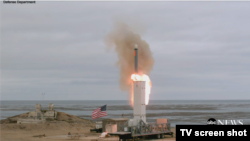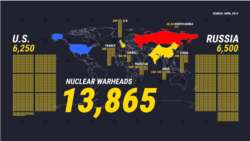The United States flight-tested an intermediate-range, ground-based ballistic missile on December 12, the second test in four months that would have been banned under a U.S.-Russia arms treaty from which Washington withdrew in August.
The Defense Department said the launch came from Vandenberg Air Force Base northwest of Los Angeles, with the rocket flying more than 500 kilometers before plunging into an open area of the Pacific Ocean.
It was a prototype missile armed with a nonnuclear warhead, Pentagon spokesman Lieutenant Colonel Robert Carver said.
Such missiles can be equipped with conventional, chemical, biological, or nuclear warheads.
Russia said it was "alarmed" by the launch.
The test further raises questions about the uncertain future of arms control.
It was the second test of a ground-launched, medium-range missile since Washington on August 2 exited the 1987 Intermediate-Range Nuclear Forces (INF) Treaty.
WATCH: Embracing The Bomb: Are We On The Brink Of A New Nuclear Arms Race? (published in July 2019)
The first test on August 18 fired a cruise missile near San Nicolas Island, off the California coast, a move for which Moscow the following day accused Washington of stoking "military tensions."
The INF banned ground-launched cruise and ballistic missiles with a range between 500 and 5,500 kilometers.
The United States and the Soviet Union deployed such missiles around Europe during the Cold War, but they were seen as acutely destabilizing because of their short flight times.
The INF Treaty did not ban intermediate-range missiles launched from sea or air.
U.S. President Donald Trump on February 1 announced the United States planned to pull out of the agreement following a six-month withdrawal period after accusing Russia of violating the pact for years.
The United States said Russia had developed and tested the 9M729 missile, also known as the SSC-8.
Vladimir Yermakov, head of the Russian Foreign Ministry's arms control and nonproliferation department, said the latest U.S. test "alarms us."
Kremlin spokesman Dmitry Peskov said it was proof that Washington's intention all along was to scrap the INF Treaty, according to comments quoted by the state-run TASS news agency.
Moscow has both denied the allegation and asserted that U.S. missile-defense systems in Eastern Europe violated the treaty -- a claim rejected by Washington.
Russia suspended its participation in the INF Treaty following Trump's February statement.











